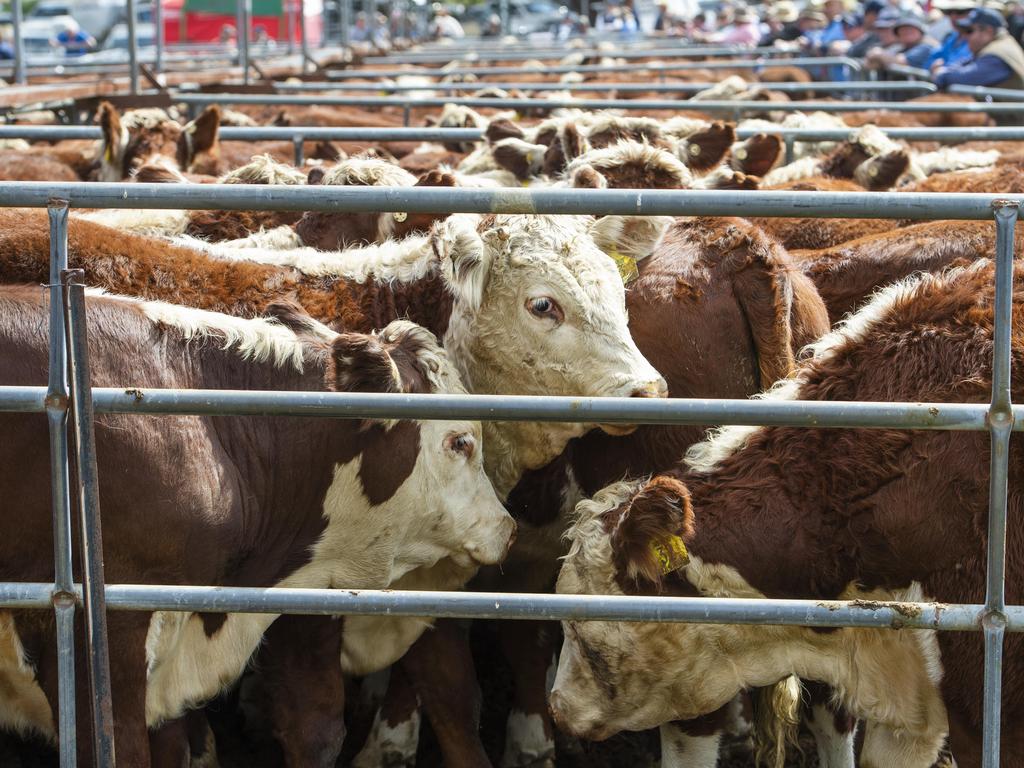Electronic collar ban: Cattle and dairy productivity choked in Vic, NSW and SA
Electronic livestock collars that create virtual fences, boost pasture utilisation and call cows into the dairy are banned in Victoria, NSW and South Australia.

The roll out of revolutionary smart electronic collars, which teach cattle to stop short of virtual fences and call cows to the dairy shed on their own, has been blocked by restrictive animal welfare laws in Victoria, NSW and South Australia.
New Zealand and Tasmanian dairy farmers are already fitting their herds with solar-powered collars, developed by Kiwi tech company Halter, which uses sound, vibration and mild electric pulses to teach cattle to avoid virtual fences, which farmers can move metre by metre using an app on their mobile phones.
One large Tasmanian dairy farmer, who has fitted his 725-cow herd with the collars, said the technology was like “speaking cow, bringing them into the dairy with no-one” and the herd learning to recognise the virtual fence within a day or two.
The collar technology is not new, having first been developed by CSIRO in 2005, with Dairy Australia completing a four-year study in 2020 that found apart from labour savings, virtual fencing boosted “consumption of home grown feed by at least 10 per cent”.
The Australian-developed version of the technology, called e-Shepherd, is due to be rolled out in October.
But while e-Shepherd customer engagement team leader Andrew Zipsin said the technology would revolutionise livestock production in Australia, it faced major regulatory barriers in Victoria, NSW and SA.
He said e-Shepherd was free to roll out its collars commercially in Queensland and had successfully worked with West Australian farmers to overturn that state’s ban.
But Victorian, NSW and SA animal welfare regulations prohibit the use of collars that can deliver an electric shock, restricting their use to research trials.
“We’re talking to (potential) customers in NSW and Victoria who ask, ‘can we have it’ (the technology)” Mr Zipsin said. “We say to them ‘we need your help to put pressure on your governments’.”
Victorian Agriculture Minister Gayle Tierney said the state was “actively participating as part of the National Animal Welfare Task Group which is examining the use of virtual fencing technology.
“Any changes to the regulation of virtual fencing would be progressed through regulations made under the new proposed (Victorian) Animal Care and Protection Act which is currently under development,” she said.
Labor first promised to introduce a new animal welfare act during the 2018 election campaign.
But after more than four years farmers, fishers, hunters and animal welfare lobbyists are still waiting for legislation to be drafted.
NSW Agriculture Minister Dugald Saunders said that while the government recognised the potential benefits of virtual fencing technology it also “recognises the importance of safeguarding animal welfare through a strong and effective regulatory framework”.
He said NSW was also part of the National Animal Welfare Task Group examinging the technology.
Meanwhile Halter has not only commercialised its collars in NZ and Tasmania, but developed in-app software that measures each cow’s grazing, resting and rumination rates to allow farmers to adjust feed intake and quickly pick up sick or lame cows and those on heat.
Halter’s growth vice president Charlie Baker said the company was serving farmers in a number of regions around the world: “The feedback we’ve had from these farmers is that our smart collars improve animal welfare, save farmers time and increase productivity.”
Mr Baker said Halter had started engaging with the Victorian Government and would continue to inform politicians and officials of the benefits of smart collars for cows and farm businesses.
“We’ve received significant interest from Victorian farmers and we look forward to further engagement with Victoria as they continue consulting on these reforms,” he said.
But getting the technology across the line in the southeast states may be challenging, with RSPCA Australia stating it “is opposed to the use of electronically activated devices that deliver an electric shock to animals”.
The RSPCA policy document on electronic collars states: “RSPCA supports the use of humane husbandry and management practices that do not cause pain, injury, suffering or distress.”
Halter’s smart collars have been independently reviewed and approved by New Zealand’s AgResearch Animal Ethics Committee.
Mr Zipsin said the eShepherd technology delivered a 1500V to 3000V pulse between two electrodes on the collar, limiting its range to a small area of the beast’s neck, whereas an electric fence sent a pulse of 7000V to 10,000V right through the animal.
Southwest Victorian dairy farmer Ben Bennett, who last November visited NZ farms using Halter as part of a Livestock Improvement Corporation tour, said the technology was taking off among Kiwi farmers as they realised it cut labour costs, optimised pasture utilisation and produced calm cows.
“Most of the activity of farmers is moving stock, but Halter does that,” Mr Bennett said. “They were so calm (the herds) when we walked among them.”
He said state bans on the collars were holding the industry back from making major productivity gains at a time when costs were rising and farmers were struggling to find labour.
“If we’re to compete in the first world’s low-cost production system we need access to first world technology,” Mr Bennett said. “But as it is we’re stuck in the dark ages.”




